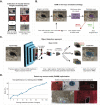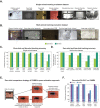This is a preprint.
DAMM for the detection and tracking of multiple animals within complex social and environmental settings
- PMID: 38293166
- PMCID: PMC10827216
- DOI: 10.1101/2024.01.18.576153
DAMM for the detection and tracking of multiple animals within complex social and environmental settings
Update in
-
DAMM for the detection and tracking of multiple animals within complex social and environmental settings.Sci Rep. 2024 Sep 12;14(1):21366. doi: 10.1038/s41598-024-72367-2. Sci Rep. 2024. PMID: 39266610 Free PMC article.
Abstract
Accurate detection and tracking of animals across diverse environments are crucial for behavioral studies in various disciplines, including neuroscience. Recently, machine learning and computer vision techniques have become integral to the neuroscientist's toolkit, enabling high-throughput behavioral studies. Despite advancements in localizing individual animals in simple environments, the task remains challenging in complex conditions due to intra-class visual variability and environmental diversity. These limitations hinder studies in ethologically-relevant conditions, such as when animals are concealed within nests or in obscured environments. Moreover, current tools are laborious and time-consuming to employ, requiring extensive, setup-specific annotation and model training/validation procedures. To address these challenges, we introduce the 'Detect Any Mouse Model' (DAMM), a pretrained object detector for localizing mice in complex environments, capable of robust performance with zero to minimal additional training on new experimental setups. Our approach involves collecting and annotating a diverse dataset that encompasses single and multi-housed mice in various lighting conditions, experimental setups, and occlusion levels. We utilize the Mask R-CNN architecture for instance segmentation and validate DAMM's performance with no additional training data (zero-shot inference) and with few examples for fine-tuning (few-shot inference). DAMM excels in zero-shot inference, detecting mice, and even rats, in entirely unseen scenarios and further improves with minimal additional training. By integrating DAMM with the SORT algorithm, we demonstrate robust tracking, competitively performing with keypoint-estimation-based methods. Finally, to advance and simplify behavioral studies, we made DAMM accessible to the scientific community with a user-friendly Python API, shared model weights, and a Google Colab implementation.
Keywords: Animal behavior; animal detection; animal tracking; computer vision; generalization; instance segmentation; machine learning; neuroscience.
Conflict of interest statement
Competing interests. The authors declare no competing interest.
Figures




References
Publication types
Grants and funding
LinkOut - more resources
Full Text Sources
